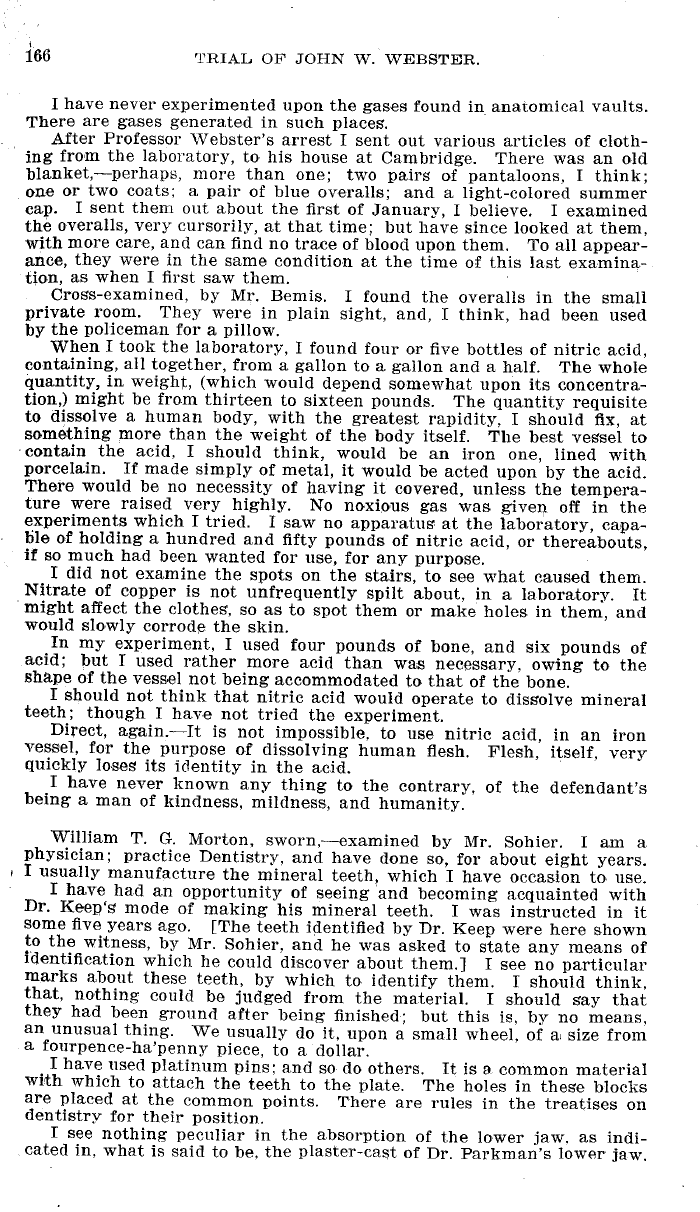|
166 TRIAL OF JOHN W. WEBSTER.
I have never experimented upon the gases found in anatomical vaults.
There are gases generated in such places.
After Professor Webster's arrest I sent out various articles of cloth-
ing from the laboratory, to his house at Cambridge. There was an old
blanket,-perhaps, more than one; two pairs of pantaloons, I think;
one or two coats; a pair of blue overalls; and a light-colored summer
cap. I sent them out about the first of January, I believe. I examined
the overalls, very cursorily, at that time; but have since looked at them,
with more care, and can find no trace of blood upon them. To all appear-
ance, they were in the same condition at the time of this last examina-
tion, as when I first saw them.
Cross-examined, by Mr. Bemis. I found the overalls in the small
private room. They were in plain sight, and, I think, had been used
by the policeman for a pillow.
When I took the laboratory, I found four or five bottles of nitric acid,
containing, all together, from a gallon to a gallon and a half. The whole
quantity, in weight, (which would depend somewhat upon its concentra-
tion,) might be from thirteen to sixteen pounds. The quantity requisite
to dissolve a human body, with the greatest rapidity. I should fix, at
something more than the weight of the body itself. The best vessel to
contain the acid, I should think, would be an iron one, lined with
porcelain. If made simply of metal, it would be acted upon by the acid.
There would be no necessity of having it covered, unless the tempera-
ture were raised very highly. No noxious gas was given off in the
experiments which I tried. I saw no apparatus at the laboratory, capa-
ble of holding a hundred and fifty pounds of nitric acid, or thereabouts,
if so much had been wanted for use, for any purpose.
I did not examine the spots on the stairs, to see what caused them.
Nitrate of copper is not unfrequently spilt about, in a laboratory. It
might affect the clothes so as to spot them or make holes in them, and
would slowly corrode the skin.
In my experiment, I used four pounds of bone, and six pounds of
acid; but I used rather more acid than was necessary, owing to the
shape of the vessel not being accommodated to that of the bone.
I should not think that nitric acid would operate to dissolve mineral
teeth; though I have not tried the experiment.
Direct, again.-It is not impossible, to use nitric acid, in an iron
vessel, for the purpose of dissolving human flesh. Flesh, itself, very
quickly loses its identity in the acid.
I have never known any thing to the contrary, of the defendant's
being a. man of kindness, mildness, and humanity.
William T. G. Morton, sworn,-examined by Mr. Sohier. I am a
physician; practice Dentistry, and have done so, for about eight years.
I usually manufacture the mineral teeth, which I have occasion to use.
I have had an opportunity of seeing and becoming acquainted with
Dr. Keep's mode of making his mineral teeth. I was instructed in it
some five years ago. [The teeth identified by Dr. Keep were here shown
to the witness, by Mr. Sohier, and he was asked to state any means of
identification which he could discover about them.] I see no particular
marks about these teeth, by which to identify them. I should think,
that, nothing could be judged from the material. I should say that
they had been ground after being finished; but this is, by no means,
an unusual thing. We usually do it, upon a small wheel, of a. size from
a fourpence-ha'penny piece, to a dollar.
I have used platinum pins; and so do others. It is a common material
with which to attach the teeth to the plate. The holes in these blocks
are placed at the common points. There are rules in the treatises on
dentistry for their position.
I see nothing peculiar in the absorption of the lower jaw, as indi-
cated in, what is said to be, the plaster-cast of Dr. Parkman's lower jaw.
|

